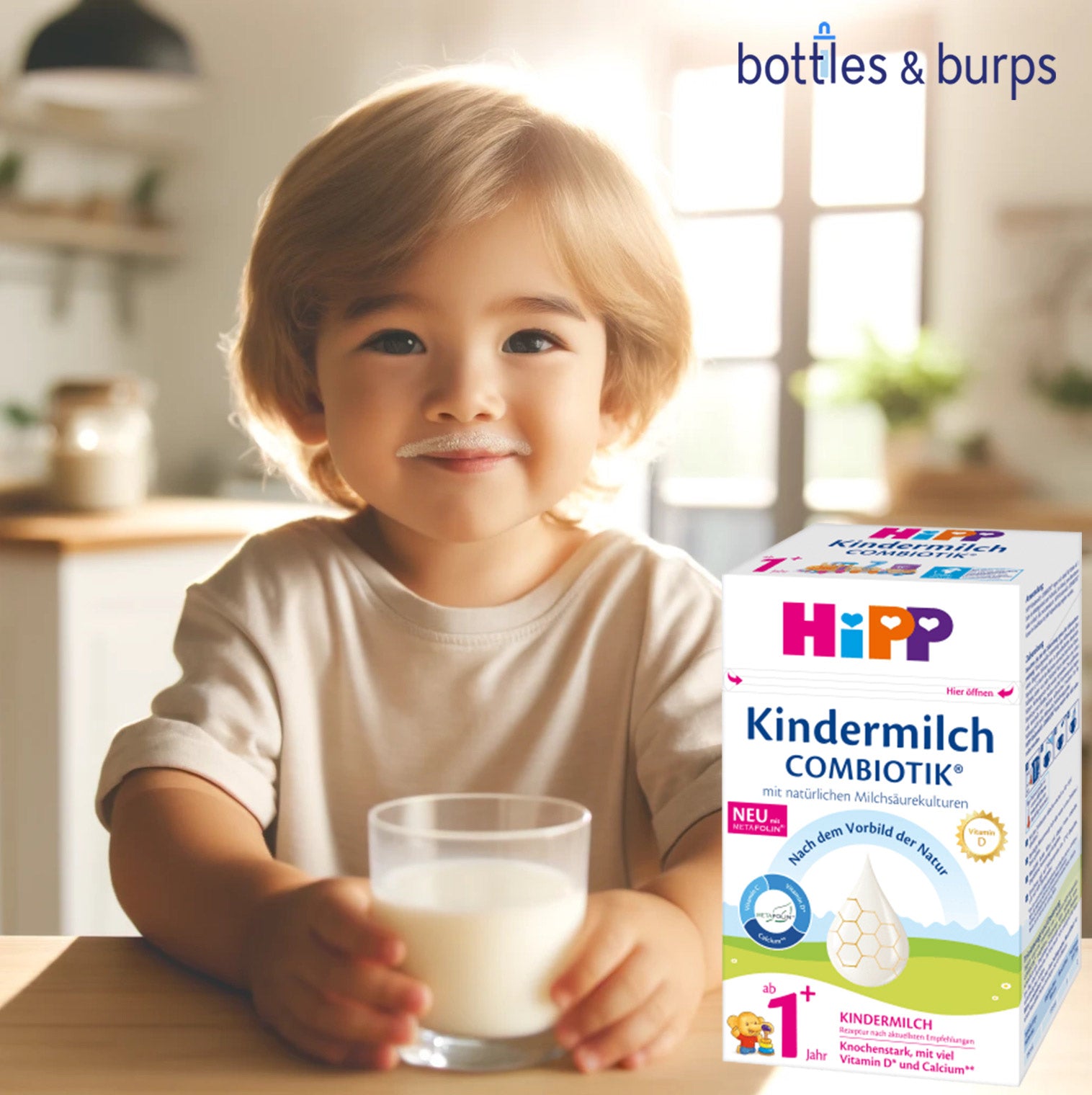FAST AND FREE SHIPPING ON MULTI-PACKS
FAST AND FREE SHIPPING ON MULTI-PACKS
Why You Should Be Considering HiPP Kindermilch 1+ For Your Toddler

Navigating the transition from infancy to the adventurous days of toddlerhood brings new challenges and decisions, particularly when it comes to nutrition. As parents consider the best way to support their child’s growth, the choice between HiPP Kindermilch and regular whole cow's milk is worth a closer look. While cow's milk has been a traditional choice for decades, HiPP Kindermilch offers a tailored nutritional profile that might better align with the needs of toddlers. Here's why:
Brain Development
- DHA & Omega Fatty Acids: HiPP Kindermilch includes DHA, an omega-3 fatty acid crucial for neural development, which is absent in cow's milk. Omega-6 fatty acids, like linoleic acid, also play a supportive role in brain health and are more abundant in HiPP Kindermilch.
Nutrient Absorption
- Iron: Iron is vital for cognitive growth and the prevention of anemia. HiPP Kindermilch has a significantly higher iron content compared to cow's milk, addressing the needs of rapidly developing toddlers.
Immune Support
- Vitamins A & C: These vitamins are essential for a strong immune system and healthy vision. HiPP Kindermilch contains higher levels than found in cow's milk, providing an extra boost to a toddler’s developing body.
Growth and Development
- Folic Acid: Continuing its crucial role from pregnancy into toddlerhood, folic acid in HiPP Kindermilch supports healthy growth and development, a feature not as prominent in regular milk.
Digestive Health
- Prebiotics: HiPP Kindermilch contains prebiotic fibers such as galacto-oligosaccharides, which promote a healthy gut flora. Regular cow's milk lacks these prebiotics.
Protein Balance:
- Protein Content: With lower protein content than cow's milk, HiPP Kindermilch is designed to be easier for toddlers to digest and to help mitigate the risk of obesity, which can be associated with higher protein intake in early years.
In sum, HiPP Kindermilch is fortified with specific nutrients that play crucial roles in a toddler's development. Its composition mirrors a more comprehensive approach to the unique dietary needs of young children, such as supporting brain development and providing key vitamins and minerals that might be lacking in their diet.
Choosing between HiPP Kindermilch and cow's milk is not just a matter of nutrition, but also about considering what’s practical and sustainable for your family. It's important to discuss your child's needs with a pediatrician, but if you're leaning towards a product designed with toddlers in mind, HiPP Kindermilch could be a valuable part of your child's diet as they step into the world with curiosity and grow with every new day.
Nutritional Comparison HiPP Kindermilch vs Whole Cow's Milk
| Nutrient Per 100ml | HiPP Kindermilch | Typical Whole Cow Milk |
|---|---|---|
| Energy (kcal) | 51 | 60-70 |
| Protein (g) | 1 | 3.2-3.5 |
| Fat (g) | 2.8 | 3.5-4 |
| - Saturated Fat (g) | 1.2 | Approx. 2.3 (varies) |
| - Monounsaturated Fat (g) | 1.2 | Approx. 1.0 (varies) |
| - Polyunsaturated Fat (g) | 0.4 | Approx. 0.2 (varies) |
| - Linolenic Acid Omega-3 (mg) | 40 | Varies (not typically added) |
| - DHA (mg) | 7.7 | Not typically added |
| - Linoleic Acid Omega-6 (mg) | 310 | Varies (not typically added) |
| Vitamin A (IU) | 120 | 50-60 |
| Vitamin D (IU) | 92 | 100 (when fortified) |
| Vitamin C (mg) | 7.7 | Trace amounts |
| Folic Acid (mcg) | 11.3 | Approx. 5 |
| Calcium (mg) | 120 | 120 |
| Iron (mg) | 1.2 | 0.03 (trace amounts) |
| Iodine (mcg) | 14 | Approx. 5-10 |
| Sodium (mg) | 20 | Approx. 40-50 |
| Prebiotics GOS (g) | 0.7 | 0 |
| Probiotics | Yes | No |
Source: Bottles & Burps Product Guide Based on Translation of HiPP German Kindermilch Labels
Subscribe
Sign up to get the latest on sales, new releases and more …
